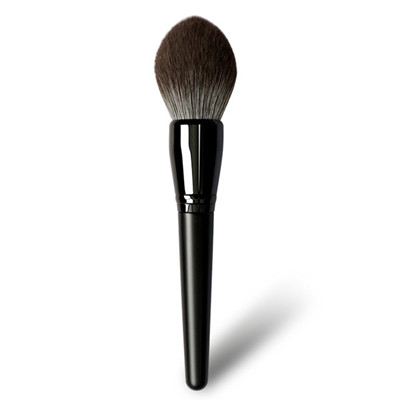►Definition and principle of antibacterial bristles
Antibacterial bristles refer to makeup brush bristles that have been specially treated or added with materials to inhibit the growth of microorganisms such as bacteria and fungi. Its core principles are divided into two categories:
- Active antibacterial: antibacterial agents (such as silver ions, zinc ions, and copper ions) are embedded in the bristles to destroy microbial cell membranes or interfere with DNA replication.
- Passive antibacterial: Reduce bacterial attachment through physical structures (such as nanoscale surface textures).
►Mainstream antibacterial technologies
1. Inorganic antimicrobial agents (mainstream technology)
| Type | Mechanism of action | Advantages and disadvantages | Representative brands/applications |
| Ag+ | Releases Ag+ to destroy bacterial enzyme system | Highly effective and broad spectrum, but high cost and may become ineffective due to oxidation | Sigma(Premium series) |
| Zn²+ | Inhibit microbial metabolism | High safety, but weak antibacterial strength | EcoTools(Part of the environmental protection line) |
| TiO₂ | Photocatalytic decomposition of microorganisms (ultraviolet light activation required) | Environmentally friendly, but dependent on light conditions | Japan Hakuhodo (experimental product) |
2. Organic antimicrobial agent
| Type | Mechanism of action | Advantages and disadvantages | Application Cases |
| Quaternary ammonium compounds | Positive charge adsorption destroys cell membrane | Fast-acting, but may irritate sensitive skin | Professional makeup artist brush (niche brand) |
| Chitosan (Chitin) | Natural polysaccharides inhibit microbial growth | Biodegradable, but poor antimicrobial durability (approximately 3 months) | South Korea AMORTALS (organic line) |
3. Physical antibacterial structure
- Nanoscale grooves: mimic shark skin texture to reduce bacterial adhesion (such as the German Zahorik Design patent);
- Superhydrophobic coating: creates a "lotus effect" on the bristle surface (regular maintenance required, easy to wear).
► Antibacterial effect and testing standards
International testing methods:
- ISO 20743 (quantitative test of antibacterial properties of textiles);
- AATCC 100 (American Association of Textile Chemists);
- JIS L 1902 (Japanese Industrial Standard).
Typical data:
- Silver ion bristles: antibacterial rate against Escherichia coli and Staphylococcus aureus >99% (24-hour test);
- Chitosan bristles: antibacterial rate 85-90% (decreased to 70% after 48-hour test).
►. Market application status
1. Main application scenarios
- People with sensitive skin: reduce acne and allergies caused by makeup brushes (such as Clinique antibacterial brush series);
- Professional makeup artists: avoid cross infection (purchase by theaters, film and television crews);
- Users in humid areas: inhibit mildew of brush hairs (focused on promotion in Southeast Asian markets).
| Type | Price range | Consumer pain points |
| Silver ion antibacterial makeup brush | $25-50 | High prices vs. persistent doubt (“Is it worth the premium?”) |
| Chitosan natural antibacterial makeup brush | $15-30 | Short-term efficacy, frequent replacement required |
| Nano physical antibacterial makeup brush | $30-60 | Poor wear resistance and high maintenance cost |
► Technical Challenges and Controversies
Safety Controversies:
- Silver ions may penetrate the skin (EU SCCS recommends a concentration of <0.5%);
- Organic antimicrobial agents have the risk of sensitization (such as quaternary ammonium salts causing contact dermatitis).
- The antimicrobial agent is lost after washing (the effect is halved after 5-10 washes on average);
- The physical structure wears out (the life of the nano coating is about 6 months).
Environmental contradictions:
- Inorganic antimicrobial agents may pollute water bodies (silver ions are toxic to aquatic organisms);
- The cost of degradable antimicrobial materials (such as chitosan) remains high.
►Future Development Direction
Composite antibacterial technology:
- Silver ion + chitosan synergistic effect (extends antibacterial cycle);
- Photocatalysis + super hydrophobic dual mode (under development by Kao, Japan).
Smart responsive materials:
- Thermo-/hygro-sensitive release of antimicrobial agents (activated only during use);
- Self-healing coatings (automatically repair nanostructures after wear).
Sustainable solutions:
- Antibacterial ingredients extracted from agricultural waste (such as rice husk silica);
- Replaceable makeup brush head design (antibacterial parts can be replaced separately to reduce waste).
►Representative product cases
Sigma Beauty Antimicrobial Collection:
- Silver ion + polyester fiber, claimed antibacterial rate is 99.9%, unit price is $35-55;
- Controversy: Third-party testing shows that the antibacterial rate drops to 89% after 10 washes.
EcoTools Renewal Series:
- Zinc ion + bamboo charcoal fiber, focusing on environmental protection and low price ($12-20);
- User feedback: The antibacterial effect is average, but the softness of the bristles is praised.
Shiseido Synchro Skin Smart Brush:
- Nano titanium dioxide coating, must be used with a UV disinfection box ($120 set);
- Technical highlights: The antibacterial rate increases by 30% after UV activation.
► Consumer Use Recommendations
Cleaning frequency: Even if you use antibacterial bristles, you still need to clean it 1-2 times a week (to avoid sebum accumulation);
Avoid exposure to the sun: Silver ion bristles are easily oxidized and ineffective in direct sunlight;







